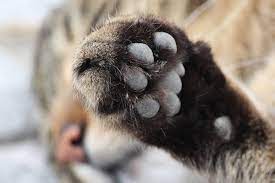Flick Their Ears When They are Asleep

The cat’s remarkable ears each have 30 muscles that control the outer ear (our ears only have 6 muscles). These muscles rotate 180° so that they can hear without moving their head. Even though they may appear to be sleeping quite often, most of the time they are only dozing, constantly searching the air for sound.
What is the Use of That Pad Midway Up the Rear Leg
It’s called the carpal pad and its function serves as an anti-skid insurance policy for any crash landings as they race around full hilt.
Why Does the Manx Cat Have No Tail
The most common Manx cat legend says that the tail was lost because the cat was the late boarding the Ark and Noah accidentally slammed the door on the tail. In fact, the lack of a tail is a true genetic abnormality that was first observed in the 16th century. The tail mutation is a serious defect. There is a hollow in the Manx’s body where the tail should be. This distorts the rest of the spine so that the Manx has a backbone with fewer and shorter vertebrae. A true Manx is called a “Rumpy”; if he has a tiny tail, he’s a “Stumpy.” He is also called a “Bunny” because his strong back legs are longer than his front. As a result, he runs with a hop.
Why Are Their Tails so Flexible?
The cat’s tail contains between 14 and 28 caudal or tail vertebrae, linked like a string of beads. Even the tailless Manx has three tail vertebrae, even though flexibility isn’t the Manx’s strong points. Short of the short tail, a Manx looks like an ordinary cat.
Provided by Pawprints and Purrs, Inc.
Related Articles & Free Email Newsletter Sign Up
How to Understand Your Cat’s Behavior
Why Cats Purr – It’s Not What You Think
Why You Should Consider Getting a Barn Cat & How to Care for Them


Comment here